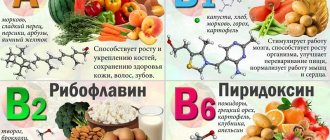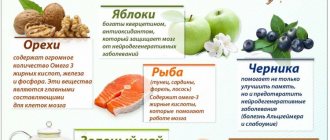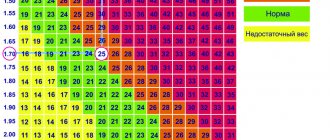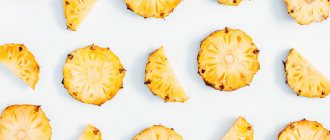According to WHO, pathological conditions associated with iodine deficiency occupy 3rd place in the list of 38 most common non-infectious human diseases. A third of the world's population belongs to the so-called risk group for developing iodine deficiency diseases (Mamenko M.E., 2013). The best situation with iodine supply is on the American continent, where the incidence of iodine deficiency diseases is minimal (10.1%). The worst is in Europe, including the CIS countries, where the prevalence of iodine deficiency diseases reaches 59.9% (Mamenko M.E., Belikh N.A., 2012). In Ukraine, the Western region has traditionally been classified as the region of maximum risk for developing iodine deficiency diseases. The accident at the Chernobyl nuclear power plant forced us to pay special attention to iodine deficiency and its consequences in the Northern and Central regions. However, after a study conducted in 2002 on the consumption of food micronutrients by the population of Ukraine, it was found that iodine deficiency is registered throughout Ukraine (Sorokman T.V., 2015). The most pronounced deficiency of this microelement in our country is observed in the mountainous areas of the western regions and Crimea. In other regions, mild iodine deficiency is observed. Only according to official statistics, almost every 10th school-age child in the country has a goiter (the main marker of iodine deficiency diseases) (Mamenko M.E., 2017). The problem of iodine deficiency in children's bodies is closely intertwined with the incidence of infectious diseases. In areas with iodine deficiency, as a rule, the frequency of infectious diseases is higher (Shcheplyagina L.A., 2012). The situation is aggravated by the fact that a lack of iodine in the body can be hidden behind nonspecific symptoms. Based on the relevance of the problem of iodine deficiency for the population of Ukraine, the prevention of iodine deficiency diseases plays an important role for people of all age groups.
WHY DOES THE BODY NEED IODINE?
Iodine is an essential trace element, the main physiological function of which is to participate in the synthesis of thyroid hormones. They, in turn, regulate the processes of growth, development, differentiation, and metabolism in all organs and tissues of the human body. The adult body contains 15–20 mg of iodine, 70–80% of which is concentrated in the thyroid gland. In conditions of iodine deficiency, the content of this microelement can decrease to 20 mcg. Under conditions of adequate iodine supply, the thyroid gland uses only 10% of the iodine entering the body, and with chronic iodine deficiency this figure can exceed 80%. Iodine accumulates in the mammary gland of a woman during lactation and is secreted into breast milk to provide for the newborn (Mamenko M.E., 2013). For the normal functioning of the thyroid gland, iodine must be supplied to the human body in a stable amount, which depends on the age and functional state of the body ( Table 1 ).
Table 1. Daily iodine requirement for people of different groups according to WHO recommendations
| Contingent | Daily iodine requirement, mcg |
| Young children (0–59 months) | 90 |
| School age children (6–12 years old) | 120 |
| Teenagers and adults (from 12 years old) | 150 |
| Pregnant and breastfeeding women | 250 |
The most stringent requirements for a sufficient and timely supply of iodine are during periods of intensive growth and development, that is, in childhood and adolescence. The need for iodine sharply increases during pregnancy and breastfeeding, since the fetus and newborn child receive this micronutrient exclusively from the mother’s body, and the hormonal characteristics of a pregnant woman cause an increase in iodine loss in the urine (Mamenko M.E., Belikh N.A., 2012 ).
Sources of iodine and methods of preventing its deficiency
Iodine belongs to the vital microelements; it is a component of the thyroid hormones: thyroxine (T4) and triiodothyronine (T3), which determine the activity of almost all metabolic processes in the body and are responsible for the formation and development of many functions of the human brain.
According to research from the Research Center of the Russian Academy of Medical Sciences and regional health authorities (1991–2006), the prevalence of endemic goiter in children and adolescents in Central Russia is 15–25%, and in individual regions - 41% (Fig.) [1–4]. At the same time, the actual average iodine consumption by a Russian resident ranges from 40 to 80 mcg per day, which is 3 times (!) less than the recommended norm, and only about 15–30% of the population regularly consumes iodized salt.
|
| Rice. The structure of thyroid pathology caused by micronutrient deficiency in children and adolescents living in the Russian Federation (according to the Ministry of Health of the Russian Federation, 2002) |
The human body does not synthesize iodine and must receive it in ready-made form. The main natural sources of iodine are products of plant and animal origin. Products fortified with iodine are carriers of high concentrations of iodine, including iodized salt, iodized bread, fermented milk products (KMPr), and adapted milk formulas for children. To eliminate and prevent deficiency of essential micronutrients in children, the inclusion of foods enriched with micronutrients (milk and CMPR) in the diet plays an important role. These products for children should provide 10–30% of the daily nutrient requirements when consuming one serving of the product, taking into account the possible negative effects of their overdose, as well as changes in organoleptic properties [5, 6]. For example, the inclusion in the diet of preschool and school-age children of balanced KMPR “Rastishka”, enriched with important micronutrients - iodine, calcium, vitamin D (Table 1), will contribute to the normal growth and development of the child’s body.
In accordance with WHO recommendations, the basic means for mass prevention of iodine deficiency diseases is iodized salt. However, for groups at increased risk of developing iodine deficiency - children, adolescents, pregnant and nursing mothers - it is necessary to use medications containing iodine.
After the birth of a child, the importance of thyroid hormones in the development of his brain and the formation of cognitive functions does not decrease; on the contrary, thyroid hormones play a very important role in the process of differentiation of neurons, growth of axons and dendrites, in the formation of synapses, gliogenesis, maturation of the hippocampus and cerebellum (throughout the first year of life), and also stimulate myelinogenesis and myelination of neurocyte processes (within 3 years of postnatal development).
The synthesis of a sufficient amount of thyroid hormones and the formation of an iodine depot in the thyroid gland of a newborn is possible only with an intake of 15 mcg of iodine per 1 kg of body weight per day, and in premature infants - 30 mcg per 1 kg. Thus, for a newborn, an adequate level of iodine intake is at least 90 mcg/day. The optimal way for newborns to obtain iodine is breast milk. A nursing woman must receive 200–250 mcg of iodine daily in the form of a medicinal product. This will fully meet the iodine needs of both her child and herself.
The need for iodine per 1 kg of body weight per day decreases significantly with age: in a newborn it is 15 mcg/kg, decreases by almost 2 times by the end of the first year of life, and for an adult this value is at the level of 2–2.5 mcg/kg.
To meet the body's need for iodine, the following daily intake standards are recommended (WHO and the International Council for the Control of Iodine Deficiency Diseases - ISKIDS (Geneva, 2001)): 90 mcg - for children 0–5 years old; 120 mcg - for school-age children (from 6 to 12 years); 50 mcg - for adolescents and adults (12 years and older); 200 mcg - for pregnant and lactating women.
The female body's need for iodine also increases during breastfeeding. WHO, UNICEF and ICIDH recommend that breastfeeding mothers consume 200 μg of iodine per day [7]. However, this amount may not be enough to cover the iodine needs of the mother and child. The content of the element in breast milk under conditions of adequate iodine supply is 150–180 mcg/l, milk production is from 0.5 to 1.1 l per day in the first 6 months of feeding, and the daily loss of iodine with milk from the mother’s body is from 75 up to 200 mcg. Thus, the need for iodine during breastfeeding in women should be from 250 to 350 mcg/day [8].
Based on these premises, a group of WHO experts developed recommendations for optimizing iodine intake levels in pregnant and breastfeeding women and children under 2 years of age. It is recommended to increase the daily iodine intake in pregnant and lactating women to 250 mcg/day. At the same time, the existing standard for iodine consumption by children under 2 years of age has been retained - 90 mcg/day. Along with this, WHO experts for the first time established levels of iodine consumption above which no additional positive effect on the functional state of the thyroid gland should be expected. However, the upper limit of the safe level of iodine intake remains unchanged - 1000 mcg/day [8].
Prevention of iodine deficiency diseases in newborns and infants. According to the US National Academy of Sciences, taking into account the average amount of milk received by a newborn (0.78 L per day), as well as the average iodine concentration in milk in countries with adequate iodine intake (146 μg/L), the average amount of iodine contained in breast milk is 114 mcg/day. In addition, a study of the balance of iodine in children's bodies showed that in a six-month-old infant, urinary iodine excretion is 90 mcg/day.
Based on these data, 90 mcg of iodine per day is recommended for children from 0 to 6 months, and 110–130 mcg/day for children over 6 months.
For breastfed infants, this issue is resolved by correcting the mother’s diet, in which great importance is attached to the regular intake of pharmacological iodine preparations during lactation. Pregnant and lactating women should receive iodine supplements so that the total daily iodine intake is 250 mcg.
A more serious problem is associated with correcting the nutrition of formula-fed infants. For children who do not receive mother's milk from birth or after 3–6 months of life, the only baby food products that can provide them with the necessary amount of iodine are artificial milk formulas enriched with the microelement (human milk substitutes) and cereals based on them.
Currently, all iodine-fortified baby food products on the Russian market are presented by foreign manufacturing companies. The quantitative spread of iodine content in baby food products is extremely wide and ranges from 33 to 170 mcg per liter of finished formula.
In accordance with the latest recommendations approved by WHO and ISICHD, the iodine content in formulas for full-term infants should be 100 micrograms per liter, and for premature infants - 200 micrograms per liter. Thus, only about half of the mixtures meet the requirements of international expert organizations in terms of the amount of iodine.
When choosing a formula, parents need to focus on the balance of its composition in all the main ingredients (proteins, fats, carbohydrates, vitamins, etc.). The iodine content is usually indicated on the packaging of the breast milk substitute (in 100 g of dry formula or in 100 ml of ready-made formula). In order for the daily dose of iodine administered with the mixture to correspond to the preventive one, its content in 100 ml of the finished mixture should be at least 9–10 mcg, and in 100 g of dry iodine - at least 70 mcg [5].
In the second half of life, the need for iodine increases slightly, and the volume of the mixture consumed decreases. In this regard, all children receiving any human milk substitutes in the second half of life need additional iodine in the composition of pharmacological tablets and/or complementary feeding products (porridge, natural products).
If the mother is breastfeeding and iodine prophylaxis is not carried out for any reason, the child needs to take at least 90 mcg of iodine daily from birth (Table 2).
When using a milk replacer with insufficient iodine content (< 9 mcg / 100 ml of ready-made formula), additional iodine is introduced into the child’s diet individually - according to the recommendations of specialists.
Ways to prevent iodine deficiency in children aged 1 to 3 years. The level of iodine content in salt during mass preventive measures corresponds to the needs of an adult receiving from 4 to 10 g of table salt per day. In children, especially under 3 years of age, the need for sodium is lower, and for iodine - slightly less than in adults: it is 90 mcg / day. Therefore, the amount of iodine a child receives from iodized table salt may not be sufficient.
To compensate for the deficiency of this microelement in this age group, along with products enriched with iodine (KMPr, cereals), physiological doses of iodine must be used in the composition of potassium iodide tablets.
Puberty. During puberty, the function of the thyroid gland undergoes certain changes associated with adaptation to the rapid pace of growth and development. At the beginning of puberty, there is an increase in thyroid-stimulating hormone (TSH) levels, followed by an increase in T4 levels. These changes are physiological and are aimed at maintaining a high level of metabolism. The increase in the volume of the thyroid gland during this period is determined not only by the influence of TSH, but also by an increase in the peripheral conversion of T4 to T3, acceleration of iodine excretion, and an increase in the synthesis of thyroxine-binding globulin. In addition, insufficient iodine intake increases the sensitivity of thyrocytes to the stimulating effect of TSH.
In iodine-deficient regions, the process of puberty is often accompanied by the formation of diffuse euthyroid goiter. Among all population groups, endemic goiter occurs most frequently in adolescents, especially girls.
During the period of rapid growth and development, the need for many microelements and vitamins increases. The preferred method of preventing endemic goiter in adolescents is the administration of potassium iodide preparations or multivitamins containing physiological doses of iodine.
Prevention and treatment of iodine deficiency diseases in Russia are of national importance, which explains the complex nature of the necessary measures.
For questions regarding literature, please contact the editor.
E. A. Troshina , Doctor of Medical Sciences, Professor N. M. Platonova , Candidate of Medical Sciences F. M. Abdulkhabirova , Candidate of Medical Sciences A. V. Sekinaeva ERC RAMS, Moscow
WHAT IS THE RISK OF IODINE DEFICIENCY?
Insufficient intake of iodine into the body is the cause of the development of a whole range of pathological conditions. Endemic goiter is traditionally considered the most significant indicator of iodine deficiency. However, the manifestations of iodine deficiency depend on its severity and the person’s age (Mamenko M.E., 2017). To this day, the classification of iodine deficiency diseases proposed in 1983 by BS Hetzel has not lost its relevance ( Table 2 ) (Mamenko M.E., 2013).
Table 2. Spectrum of iodine deficiency diseases
| Life period | Manifestations |
| Fetus | Abortion, stillbirth Congenital disorders Increased perinatal and infant mortality Neurological cretinism: mental retardation, deaf-muteness, strabismus Myxedematous cretinism: mental retardation, hypothyroidism, dwarfism Psychomotor impairment |
| Newborns | Neonatal hypothyroidism |
| Children and teenagers | Impaired mental and physical development |
| Adults | Goiter and its complications |
| Any age | Goiter Hypothyroidism Impaired cognitive function Increased sensitivity of the thyroid gland to iodine absorption |
The role of thyroid hormones is extremely important during pregnancy. If the mother has severe iodine deficiency, then the child’s brain is formed “with errors.” As a result, the newborn may suffer from severe mental retardation, deafness, and impaired psychomotor development.
Iodine deficiency has a detrimental effect on the development of a child during critical age periods. Iodine deficiency reduces cognitive functions by 8–44% in preschool children and by 11–38% in schoolchildren. It is believed that iodine deficiency is also responsible for the so-called difficult age in adolescents and can negatively affect their physical and puberty (Kurmacheva N.A., 2014; Skvortsov V.V. et al., 2017).
In adult life, a lack of iodine in the body can lead to reproductive health problems, worsen cognitive function, and lead to emotional disorders: irritability, worsening mood, drowsiness, weakness, etc. In old age, symptoms of iodine deficiency may be attributed to the normal aging process. The most common symptoms at this age are neurological disorders and mental disorders, including depression, behavioral and cognitive dysfunction.
Iodine deficiency causes a decrease in the intellectual potential of the entire population living in the zone of iodine deficiency. The IQ level of the population living in regions with iodine deficiency is 15–20% lower than in regions without iodine deficiency (Korzun V.N. and spivat., 2011).
Excess iodine in the body
It is no less dangerous than its deficiency, and entails irritability, weakness, sweating, emaciation, a tendency to diarrhea, early graying, and muscle atrophy. Excess iodine is dangerous for various diseases of the thyroid gland; Graves' disease with goiter can develop.
It is quite difficult to obtain excess iodine only by consuming iodine-containing foods. Even iodized salt will not give such an effect, but if you have problems with the thyroid gland, you should immediately stop self-medicating and eating seaweed and be sure to consult a doctor to correct your diet.
The fact is that for diseases of the thyroid gland, foods that contain iodine are often contraindicated, and you should also exclude any cabbage, radish, radish, carrots, turnips, Jerusalem artichoke, spinach, and peaches from your diet.
FREQUENTLY ILL CHILDREN: WHAT IS THE ROLE OF IODINE LACK?
Children who often and for a long time suffer from acute respiratory infections (ARI) are usually allocated to a separate group of dispensary observation. These children deserve special attention, since frequent ARIs can lead to deterioration of adaptation mechanisms, dysfunction of organs and systems, and cause the early development of chronic pathology. It is assumed that the increase in the number of many acute and chronic diseases in areas with iodine deficiency is due to the significant prevalence of subclinical hypothyroidism. In children, against the background of chronic iodine deficiency, there is an increase in the incidence of acute respiratory infections, sore throats, and pneumonia, which is caused by the inhibition of humoral and cellular factors of nonspecific protection. At the same time, the infectious process is distinguished by its severity, tendency to relapse, and slowing of the immune response to bacteria and viruses (Shcheplyagina L.A., 2012). Among children living in conditions of iodine deficiency who have not received iodine prophylaxis, the proportion of those who frequently suffer from ARI reaches 70.5% (Kurmacheva N.A., 2012).
Violation of humoral, especially local, immunity under conditions of iodine deficiency leads to increased adhesion of microbes and viruses to the surface of the mucous membrane, which can subsequently lead to its deep structural damage. Under these conditions, the barrier functions of the mucous membrane are reduced, which can lead to the generalization of the infectious process (Shcheplyagina L.A., 2012).
Sea kale
Just 100 grams of seaweed per day - and the daily requirement for iodine is met. It is not surprising that cabbage has a characteristic iodine smell - there is a lot of iodine here, and it is also easily absorbed. In addition to iodine, you can get vitamins A, E, C, group B, as well as iron and magnesium from cabbage.

Millet and seaweed casserole
200 g seaweed 1 cup millet 2 onions 4 tbsp. butter 2 eggs 3 tbsp. sour cream 3 tbsp. bread crumbs 100 g grated cheese
Step 1. Rinse the millet thoroughly and cook a viscous porridge (for 1 cup of cereal - 3 cups of water). Step 2. Fry the onion in vegetable oil and add to the porridge. Cool until warm. Step 3. Add seaweed and eggs to the porridge. Place in a mold greased with butter and sprinkled with breadcrumbs. Step 4. Mix cheese with some crackers and sour cream. Place on top of the casserole and smooth out. Step 5. Bake in the oven for 15 minutes at 200 C.
Foods rich in iodine
The list of foods rich in iodine primarily includes seafood. Small doses of the nutrient are present in vegetables, grains, milk, etc.
Fish and seafood
Fish and seafood contain a lot of iodine. However, in the first case, this applies only to oceanic varieties.
To compensate for the deficiency, it is recommended to consume the liver of cod, squid, hake, pollock, perch, pink salmon, tuna, capelin, chum salmon, flounder and mackerel.
Shrimp are good for you. Sea kale is suitable for vegetarians.

Shrimp contain large amounts of iodine.
Cereals
The concentration of iodine in cereals is so low that it is often equated to 0. Among cereals, wheat contains the most nutrients.
It contains 10 mcg of iodine. To get the daily requirement, an adult will have to eat 1.5 kg of wheat. This is impractical, so cereals are not suitable as a source of microelements. The least amount of nutrient is found in buckwheat, rice and millet.
Legumes and grains
Grains and cereals contain little iodine. Peas and lentils are record breakers: they contain only 1.3 and 3.5 mcg, respectively. Beans contain 12 mcg of iodine, but this is only enough to partially satisfy the daily requirement.
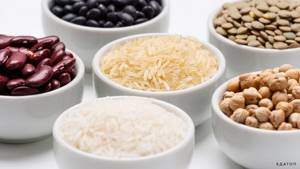
Legumes and grains do not contain much iodine.
Vegetables and fruits
The only fruit that is rich in iodine is feijoa. According to various estimates, it contains from 300 to 5000 mcg of the nutrient.
Next on the list is grapes, which contain only 8 mcg.
In other fruits the dosage is even less. Among vegetables, garlic is the record holder: 100 g contains 9 mcg of microelement. There is relatively a lot of iodine in radishes and beets. In other vegetables the amount of nutrient is insignificant.
Dried fruits
In this category, the record holder is raisins. Next comes the apricot. Dried fruits cannot be used even as a secondary source of iodine, since they contain a lot of calories and sugars and too little of the nutrient itself.

Raisins contain some iodine.
Dairy
The most iodized dairy product is skimmed milk powder. In 100 g of condensed milk there is only 5% of the daily dose of the nutrient.
Dairy products
The concentration of iodine in fermented milk products is insignificant. Full-fat sour cream contains 7 mcg of the nutrient, but this is too little to meet the daily requirement.
Eggs
Egg powder has a high concentration of microelements: 100 g contains as much as 43% of the daily dosage. However, this is a concentrated product. The white of a fresh egg contains only 7 mcg of the nutrient, which equates to 0. The yolk is more nutritious: it contains 33 mcg.
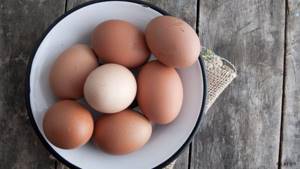
100 g of egg powder contains 43% iodine.
Iodine content table
The iodine content of different foods is shown in the table below.
| Product | How much iodine is contained in 100 g, mcg |
| Cod liver | 369 |
| Haddock | 244 |
| Saida | 210 |
| Salmon | 190 |
| Fresh shrimp | 180 |
| Flounder | 180 |
| Smoked mackerel | 140 |
| Sea bass | 140 |
| Cod | 137 |
| Boiled shrimp | 112 |
| Fresh mackerel | 103 |
| Fresh herring | 90 |
| Salted herring | 75 |
| Raw oysters | 61 |
| Ham | 52 |
| Smoked fish fillet | 41 |
| Bread | 30 |
| Sardines in oil | 25 |
| Oats | 21 |
| Champignon | 17 |
| Processed cheese | 17 |
| Egg | 17 |
| Pork | 16 |
| Whole milk | 18 |

